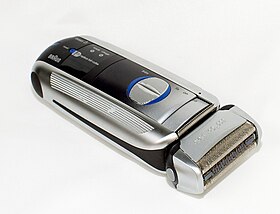
Shaving is the removal of hair, by using a razor or any other kind of bladed implement, to slice it down—to the level of the skin or otherwise. Shaving is most commonly practiced by men to remove their facial hair and by women to remove their leg and underarm hair. A man is called clean-shaven if he has had his beard entirely removed.

A lawn mower is a machine utilizing one or more revolving blades to cut a grass surface to an even height. The height of the cut grass may be fixed by the design of the mower, but generally is adjustable by the operator, typically by a single master lever, or by a lever or nut and bolt on each of the machine's wheels. The blades may be powered by manual force, with wheels mechanically connected to the cutting blades so that when the mower is pushed forward, the blades spin, or the machine may have a battery-powered or plug-in electric motor. The most common self-contained power source for lawn mowers is a small internal combustion engine. Smaller mowers often lack any form of propulsion, requiring human power to move over a surface; "walk-behind" mowers are self-propelled, requiring a human only to walk behind and guide them. Larger lawn mowers are usually either self-propelled "walk-behind" types, or more often, are "ride-on" mowers, equipped so the operator can ride on the mower and control it. A robotic lawn mower is designed to operate either entirely on its own, or less commonly by an operator by remote control.

A pencil sharpener is a tool for sharpening a pencil's writing point by shaving away its worn surface. Pencil sharpeners may be operated manually or by an electric motor. It is common for many sharpeners to have a casing around them, which can be removed for emptying the pencil shavings debris into a trash bin.

A razor is a bladed tool primarily used in the removal of unwanted body hair through the act of shaving. Kinds of razors include straight razors, disposable razors, and electric razors.

A string trimmer, also called a "weed eater", "whipper-snipper", "weed-whacker", "weed-whip", "line trimmer" or "strimmer", is a garden tool for cutting grass and groundcover which uses a flexible monofilament line instead of a blade. It consists of a rotating spindle from which the string protrudes, at the end of a long shaft with a handle. String trimmers are commonly used for cutting low foliage near obstacles or on steep or irregular terrain.
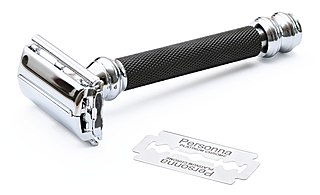
A safety razor is a shaving implement with a protective device positioned between the edge of the blade and the skin. The initial purpose of these protective devices was to reduce the level of skill needed for injury-free shaving, thereby reducing the reliance on professional barbers.
Gillette is an American brand of safety razors and other personal care products including shaving supplies, owned by the multi-national corporation Procter & Gamble (P&G).
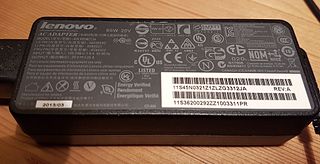
An AC adapter, AC/DC adapter, or AC/DC converter is a type of external power supply, often enclosed in a case similar to an AC plug. Other common names include plug pack, plug-in adapter, adapter block, domestic mains adapter, line power adapter, wall wart, power brick, and power adapter. Adapters for battery-powered equipment may be described as chargers or rechargers. AC adapters are used with electrical devices that require power but do not contain internal components to derive the required voltage and power from mains power. The internal circuitry of an external power supply is very similar to the design that would be used for a built-in or internal supply.

Philishave was the brand name for the electric shavers manufactured by the Philips Domestic Appliances and Personal Care unit of Philips. In recent years, Philips had extended the Philishave brand to include hair clippers, beard trimmers and beard shapers. Philips used the Philishave brand name for their shavers from 1939 to 2006.
X-Acto is a brand name for a variety of cutting tools and office products owned by Elmer's Products, Inc. Cutting tools include hobby and utility knives, saws, carving tools and many small-scale precision knives used for crafts and other applications.

Schick is a brand of personal care and safety razors owned by Edgewell Personal Care. The company was founded in 1926 and was purchased by Energizer in 2003 from Pfizer. Energizer split into two companies in 2015 and Schick became part of Edgewell Personal Care.

The Wahl Clipper Corporation, is an American grooming company based in Sterling, Illinois. Wahl manufactures grooming products for people and animals.

An epilator is an electrical device used to remove hair by mechanically grasping multiple hairs simultaneously and pulling them out. The way in which epilators pull out hair is similar to waxing, although unlike waxing, they do not remove cells from the epithelium of the epidermis. Aside from the spring in early spring-type epilators, there are no parts in epilators that require regular replacement. Epilators come in corded, rechargeable and battery-operated designs. The battery-operated devices can be used wet or dry. They may also come with various attachments, like a smaller head to help with epilation of hard-to-reach areas, or an exfoliation head that may help exfoliate the skin before and after epilation.

A hedge trimmer, shrub trimmer, or bush trimmer is a gardening tool or machine used for trimming hedges or solitary shrubs (bushes). Different designs as well as manual and powered versions of hedge trimmers exist.

Judaism prohibits shaving with a razor on the basis of a rabbinic interpretation of Leviticus 19:27, which states, "You shall not round off the side-growth on your head, or destroy the side-growth of your beard." The Mishnah interprets this as a prohibition on using a razor on the beard. This prohibition is further expanded upon in kabbalistic literature. The halakhic prohibition applies to shaving off the pe'ot (sidelocks) and corners of the beard by means of a razor.
Remington Products, commonly known as simply Remington, is a worldwide personal care corporation which manufactures razors (shavers), epilators, and haircare products for both men and women. It is a subsidiary of Spectrum Brands and Oak Hill Capital.

An automobile auxiliary power outlet in an automobile was initially designed to power an electrically heated cigarette lighter, but became a de facto standard DC connector to supply electrical power for portable accessories used in or near an automobile, directly from the vehicle's electrical system.

The Black & Decker DustBuster is a cordless vacuum cleaner that was introduced in January 1979.
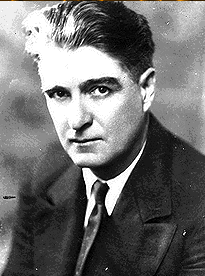
Col. Jacob Schick was an American inventor and entrepreneur who patented the first electric razor and started the Schick Dry Shaver, Inc. razor company. He is the father of electric razors. Schick became a Canadian citizen in 1935 to avoid an investigation by the Joint Congressional Committee on Tax Evasion & Avoidance after he moved most of his wealth to a series of holding companies in the Bahamas.
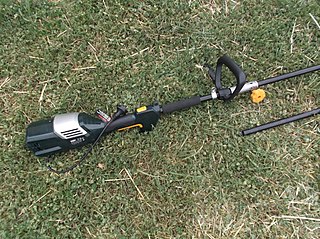
A brushcutter is a powered garden or agricultural tool used to trim weeds, small trees, and other foliage not accessible by a lawn mower or rotary mower. Various blades or trimmer heads can be attached to the machine for specific applications.

